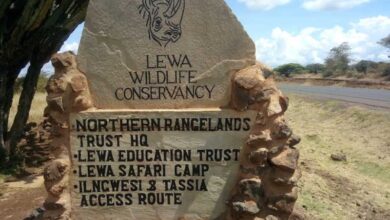
Marsabit National Park & Reserve is situated on Mount Marsabit, close to Marsabit town in northern Kenya. It is 560 kilometers north of Nairobi. The Great Rift Valley’s eastern side is where it is located, and it has a total area of around 1,554 square kilometers. The Marsabit Mountain, a volcanic mountain in the region, is included in the park.
The complex and distinctive environment of Marsabit National Park, which includes lush woods and semi-desert plains, is well-known. Elephants, lions, leopards, buffaloes, giraffes, zebras, and numerous antelope species are among the many wildlife species that call the park home. With over 280 bird species reported, including rare and endangered species like Williams’s lark and the vulturine guineafowl, it is also an important home for bird species.

Lake Paradise, a crater lake at the top of Marsabit Mountain, is one of the main attractions of Marsabit National Park. It offers breathtaking views and is a vital water source for wildlife. Additionally, visitors can explore the extensive woodlands and come across unusual plant species like the African rosewood and the enormous cycad.
Game drives, nature hikes, birdwatching, and camping are all possible activities in the park. It is significant to highlight that visiting Marsabit National Park involves careful planning and frequently the assistance of local guides or tour providers due to its isolated location and difficult terrain. In a less traveled and off-the-beaten-path area, Marsabit National Park offers the chance to enjoy Kenya’s natural beauty, wildlife, and cultural legacy. It is a unique destination for those seeking an authentic African safari experience.

Marsabit National Park Activities
1.Hiking
The terrain of Marsabit National Park is made up of an extinct volcano that rises 1,707 meters above sea level. This volcano is covered in a dense forest with a wide variety of tree species, which is home to a wide range of animals and birds. A ranger guide will assist you as you trek to the top of the volcano while traversing well-maintained routes on this volcano.
2. Bird Watching
A birder guide who is knowledgeable about where to see the birds will assist you as you follow paths throughout your bird-watching safari adventure in the park. The Somali bee-eater, masked lark, Somali sparrow, and migratory bird species can all be seen throughout this trip. The African olive pigeon, bearded vulture, hartlaub’s turaco, Heuglin’s bustard, small grebe, masked lark, and numerous other bird species can be found at Marsabit National Park.

3. Visit the Singing Wells
The Samburu families will be taking their herds of cattle to the Singing Wells, where they will be able to observe them as they dig for water to fill troughs for their cows, goats, and camels. These wells are deep for a significant portion of the year, so it often takes a chain of individuals to pass up a bucket in order to quench the thirst of their livestock. Each family leads the cattle to their family well while chanting or singing their family song, and amazingly, the cattle are able to recognize it.
4. Rock climbing
A skilled guide with thorough local expertise can lead you on some fantastic climbing routes on the imposing Ol Olokwe massif, which is located south of Marsabit. It is an amazing pastime.
5. Game Viewing
Sightings of species like Zebras, Elephants, Lions, Giraffes, Buffaloes, Black and White Colobus, Blue Monkeys, Bushbucks, Sunis, and Leopards among others make game viewing in this park rewarding.




